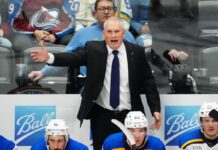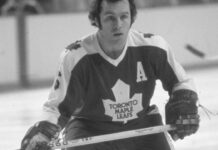People will often ask what you remember most about a particular player from years gone by.
It’s natural to offer a quick response, such as a player who was extraordinarily fast, or a great playmaker, or particularly tough, or even a great fighter in the olden days when that was actually a thing.
But when I think of long-time Maple Leaf great George Armstrong, who we heard yesterday had passed away at the age of 90, those aren’t necessarily the things that come to mind— though he was surely tough and a fine playmaker.
For those who did not see him play in his hey-day (I was fortunate to have seen him in person—George scored a goal in the very first Leaf game I ever went to at the Detroit Olympia in the early 1960s—and countless times on television), the thing that stands out for me is that he was this constant, steady presence in the Leaf lineup. Armstrong was a Leaf you always relied on to do his job, and do it really well. He was seemingly always ‘there’ — ready to do battle at home and on the road. He was at the center of all things blue and white.
In good times and difficult times, he was the ultimate Maple Leaf.
I was a very young but avid Leaf fan by the late 1950s, and “Army” was always our Captain, at least until his first retirement in the late 1960s when Dave Keon accepted the Captain’s “C.”
It was not easy replacing Armstrong, who was indisputably the leader of the Leafs. Even as a boy, we learned and began to understand as hockey fans that Armstrong’s personal background was a bit different—his mom was Iroquois, and George was naturally proud of his heritage. There were very few NHLers representing indigenous culture at the time, and Armstrong was no doubt the best known. (And yes, he was known as “The Chief.” It was a nickname he seemed to wear with pride, and it was, I thought through the years, said of him with respect.)
So what exactly made Armstrong such an important Leaf, and a Hall-of-Famer to boot?
Well, it wasn’t that he was fleet of foot, that’s for sure. He was strong on his skates, but speed wasn’t his strong suit. I used to read way back then about how Army would make fun of his own lack of upper-body strength, in that he was not super muscular. That may have been the case, but man, there were few if any guys harder on the puck or better in the corners or along the boards in the ‘50s and ‘60s than Armstrong.
It was very, very hard to get the puck away from him. As we know in hockey, if your guys have it, the other team doesn’t.
Armstrong had it a lot— and in important spots on the ice.
He was rugged and strong on his skates. He had an excellent wrist shot (he wasn’t much of a slap shot guy, even as the game changed over the years). He saw the ice well, with really good anticipation and great “hockey sense.”
He was a high-end penalty-killer because, like his much faster and much younger linemate Davey Keon, he was smart, an extremely hard worker, understood angles, and played them about as well as you can. (On that note, it’s always been a wonderful mystery—perhaps not really a mystery as much as a simple joy—that Keon centered Armstrong for pretty much the last half of George’s 20+ year NHL/Maple Leaf career. Dave was considered one of the fastest guys in the NHL at the time, and Armstrong was…. not. But they were an exceptional two-way pairing along with an array of wingers they played with over the years, a group that included Dickie Duff in the early ‘60s. That line was a treat to watch.)
And then there was this quiet but fierce determination. Armstrong was not a fighter, but he sure was rugged. He was not by all accounts a yeller or a screamer as Captain and team leader. He had an interesting group to deal with. While the loved/hated and very intense Punch Imlach ran the show in Toronto in those days as both General Manager and Coach, Armstrong was the go-between when it came to the Leaf players.
You had older guys like Red Kelly, Tim Horton, Allan Stanley, Johnny Bower, and (in the early ‘60s, at least) kids like Keon, Nevin, Duff, and later Ronnie Ellis, all of whom would do what they were told because Imlach was the guy in charge. They may not have liked it, but they respected Imlach’s position.

But you also had individuals such as Carl Brewer and Bobby Pulford, two of the fellows that weren’t quite so willing to be pushed around by Imlach and who were, if I am remembering correctly, at the forefront of trying to organize players. They brought in a young Alan Eagleson to help the players understand they had rights and some degree of “power” as well that they should not be afraid to utilize.
Somehow, Armstrong adroitly navigated being in the player’s corner while still being trusted by Imlach during this era. He was respected by both “sides” of the player-management relationship, and that was no easy balancing act in those days in hockey when owners ruled the roost.
I remember a story from many years ago, sometime in the ‘60s, in an old hockey magazine I would devour when I was a kid. Imlach had a gripe during a particular game with a referee and ordered Army to relay Punch’s anger and dissatisfaction. Armstrong knew Imlach was off-base in this particular instance, but he did his duty and went over to the ref, gesticulating and yelling.
After the show was over, he went back to Punch and told him “no dice” — the ref wasn’t budging on whatever the issue of the moment was. But Armstrong had publicly “defended” Punch.
It was some time later, as he recounted the story, that George acknowledged he had simply gone up to the ref, shaking his arms and yelling, and told the him he had to make a show because Punch was upset. Basically, it went, “Just let me do this, so I can go back and tell Punch I really tried.” I remember thinking, even as a boy, how hilarious of a scene that was.
That was one of Armstrong’s many gifts. When it was time to defend the Leaf honour in a game or situation that mattered, Armstrong was the first guy over the boards. But he also knew when enough was enough. He had enough pride, dignity, and self-awareness to know that there were times you just have to come back and fight another day. You don’t always “win.”
I have to believe George Armstrong was one of the most respected Maple Leafs of all-time, which could be affirmed if we had been able to survey not just his teammates but his opponents as well. How could you not like, respect, and admire George Armstrong?
He played hard and he played to win. He captained the Leafs to those four Stanley Cup championships in the 1960s and was still an effective player in his early 40s (and still killing penalties) before he retired for the last time after the 1970-’71 NHL season. That was a season that saw a mostly very young Leaf team (aside from Armstrong, Keon and Norm Ullman) battle a really good Rangers squad under Emile Francis, before bowing out in six tough playoff games.
Of course, George is remembered — understandably, since we haven’t experienced a Cup-clinching goal in Toronto for over 50 years — for his empty-net goal late in Game 6 of the Leafs-Montreal final at Maple Leaf Gardens on May 2, 1967. That goal assured the Leafs of a very unexpected championship that season.
George was on the ice for a critically important faceoff to the left of Terry Sawchuk in the Leaf net. Imlach put his “old guard” on for the faceoff— Kelly, Pulford, Tim Horton, and Allan Stanley.
Punch liked to use his defensemen at times for faceoffs in his own zone (we would not see that nowadays, eh?), so Stanley took the draw against Hab legend Jean Beliveau. The puck squirted through Beliveau to Kelly, who nudged it to Pulford, who in turn found Armstrong “streaking” (I’m using that term lightly, but George was moving quickly, his usual hard-driving, choppy strides making ground) beyond the Leaf blueline into what we now refer to as the neutral zone.
Armstrong waited until he crossed the red line and wristed a shot past Jacques Laperriere and into the empty net.
As the Leafs celebrated on the ice after the game with the Stanley Cup, George’s son was on the ice with the team, and his Dad invited him over to touch and hold the Cup as the rest of the Leafs rushed over to have their pictures taken with George and the Cup. I’m not sure how often families were involved in the Cup celebrations in those days, but it was very cool to see.
Yet, as wonderful of a memory that is in George’s career and for those of us around to experience it (I was 13 at the time, a little older than that now), it was hardly something that defined Armstrong.
He was more than “just” a hockey player.
He was a humble guy from humble origins. I cannot speak to what, if any, kind of discrimination, hardship, or injustice he might have faced as a boy or young man, although surely he had challenges to overcome. As with so many people of great character and high aspirations, he navigated the life challenges he faced and was able to make hockey—something he certainly seemed to love every time I had a chance to see him play—into a professional career, and a highly successful one at that.
Armstrong went on to coach the Toronto Junior A Marlboroughs for a few years in the early to mid-1970s. I was a university student in Toronto at the time in those years and would on occasion head down to the Gardens to catch a game. The Howe brothers—Marty and Mark—were there for a time. Mike Palmateer, of course. Bob Daily, an excellent defenseman, was too. There was also the speedy Paulin Bordelau. After winning a couple of championships, George eventually stepped aside as coach.
The Leafs and then owner Harold Ballard tried to get Armstrong to coach the big club a number of times through the years. George accepted the job on an interim basis one season in 1988-89, but he very much wanted not to coach the Maple Leafs. I imagine it was just something he knew he wouldn’t enjoy. He never wanted the limelight and didn’t seek out media attention. He was just a good man — a family man who was highly regarded and respected by all.
He was a scout for many years with the blue and white, not that you ever heard a lot about him. He was very private, rarely getting involved in some of the Leaf projects that would include some of the great former Leafs from time to time.
Armstrong lived to be 90, by all accounts happy and content.
He was a huge success on the ice and an inspiration to many both on—and off— the ice.
A really good man. A really good player. A really good Maple Leaf. Our Captain in some of our greatest times.
He leaves us, sadly, but he gave us a treasure trove of memories and examples to reflect on and feel good about. Thank you, Army. Rest well.
Part of the very fabric of the Toronto Maple Leaf organization.
Rest In Peace, George. You will be deeply missed. pic.twitter.com/xzLl8CwX4D
— Toronto Maple Leafs (@MapleLeafs) January 24, 2021

































![New Leaf Anthony Stolarz on the opportunity in Toronto: “In Florida, I knew my role as a backup… Now, [Joseph Woll] and I are competing for starts… As a goalie, that’s all you can ask for” Anthony Stolarz, Stanley Cup win, now Maple Leaf](https://mapleleafshotstove.com/wp-content/uploads/2024/07/anthony-stolarz-sc-100x70.jpg)
